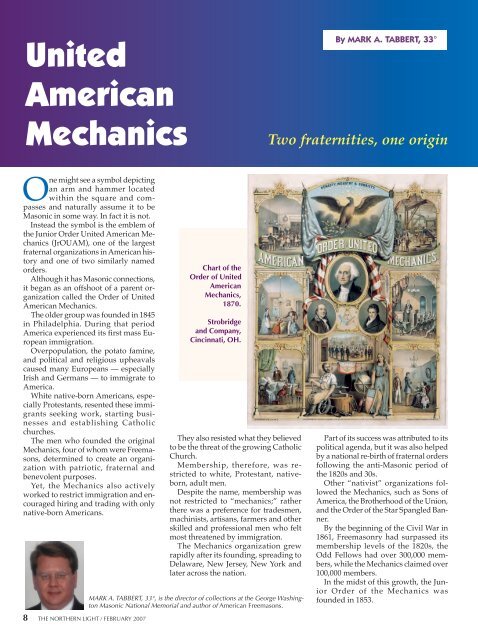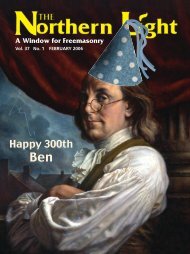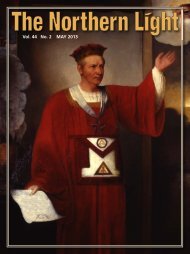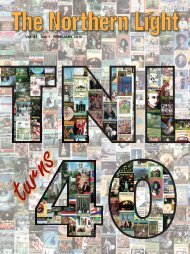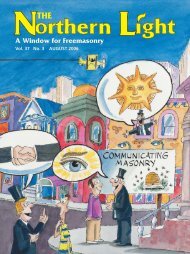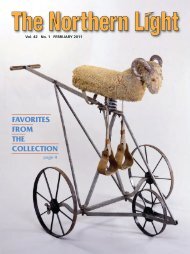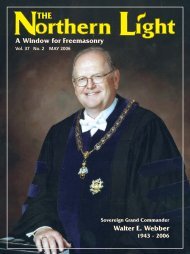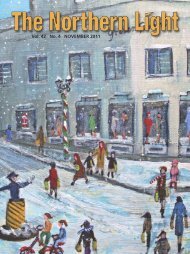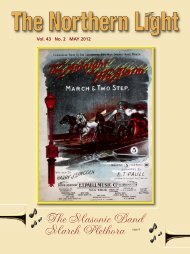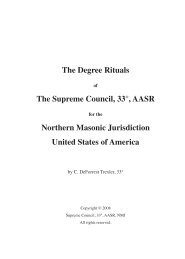February - Scottish Rite
February - Scottish Rite
February - Scottish Rite
You also want an ePaper? Increase the reach of your titles
YUMPU automatically turns print PDFs into web optimized ePapers that Google loves.
United<br />
By MARK A. TABBERT, 33°<br />
American<br />
Mechanics<br />
Two fraternities, one origin<br />
One might see a symbol depicting<br />
an arm and hammer located<br />
within the square and compasses<br />
and naturally assume it to be<br />
Masonic in some way. In fact it is not.<br />
Instead the symbol is the emblem of<br />
the Junior Order United American Mechanics<br />
(JrOUAM), one of the largest<br />
fraternal organizations in American history<br />
and one of two similarly named<br />
orders.<br />
Although it has Masonic connections,<br />
it began as an offshoot of a parent organization<br />
called the Order of United<br />
American Mechanics.<br />
The older group was founded in 1845<br />
in Philadelphia. During that period<br />
America experienced its first mass European<br />
immigration.<br />
Overpopulation, the potato famine,<br />
and political and religious upheavals<br />
caused many Europeans — especially<br />
Irish and Germans — to immigrate to<br />
America.<br />
White native-born Americans, especially<br />
Protestants, resented these immigrants<br />
seeking work, starting businesses<br />
and establishing Catholic<br />
churches.<br />
The men who founded the original<br />
Mechanics, four of whom were Freemasons,<br />
determined to create an organization<br />
with patriotic, fraternal and<br />
benevolent purposes.<br />
Yet, the Mechanics also actively<br />
worked to restrict immigration and encouraged<br />
hiring and trading with only<br />
native-born Americans.<br />
Chart of the<br />
Order of United<br />
American<br />
Mechanics,<br />
1870.<br />
Strobridge<br />
and Company,<br />
Cincinnati, OH.<br />
They also resisted what they believed<br />
to be the threat of the growing Catholic<br />
Church.<br />
Membership, therefore, was restricted<br />
to white, Protestant, nativeborn,<br />
adult men.<br />
Despite the name, membership was<br />
not restricted to “mechanics;” rather<br />
there was a preference for tradesmen,<br />
machinists, artisans, farmers and other<br />
skilled and professional men who felt<br />
most threatened by immigration.<br />
The Mechanics organization grew<br />
rapidly after its founding, spreading to<br />
Delaware, New Jersey, New York and<br />
later across the nation.<br />
MARK A. TABBERT, 33°, is the director of collections at the George Washington<br />
Masonic National Memorial and author of American Freemasons.<br />
Part of its success was attributed to its<br />
political agenda, but it was also helped<br />
by a national re-birth of fraternal orders<br />
following the anti-Masonic period of<br />
the 1820s and 30s.<br />
Other “nativist” organizations followed<br />
the Mechanics, such as Sons of<br />
America, the Brotherhood of the Union,<br />
and the Order of the Star Spangled Banner.<br />
By the beginning of the Civil War in<br />
1861, Freemasonry had surpassed its<br />
membership levels of the 1820s, the<br />
Odd Fellows had over 300,000 members,<br />
while the Mechanics claimed over<br />
100,000 members.<br />
In the midst of this growth, the Junior<br />
Order of the Mechanics was<br />
founded in 1853.<br />
8 THE NORTHERN LIGHT / FEBRUARY 2007


